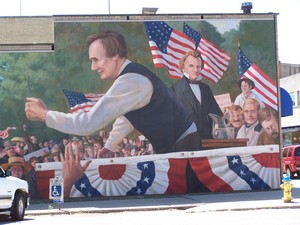Illinois’ Friendly City Then and Now
Ottawa, Illinois, some eighty miles southwest of Chicago, along I-80, claims the slogan “Friendly City” for itself. In recent years, Ottawa has been a growing regional “prairie” site for the arts, perhaps spurred on by the increasingly famous outdoor murals that adorn many of the buildings called, “A Bush With History.” Each mural depicts an historical event in the city’s history.
Lincoln in the Friendly City
That slogan must be true. A lawyer and aspiring politician, Abraham Lincoln, was a frequent visitor to then small hamlet. He also made history here.
Ottawa has been a favorite rendezvous spot for centuries due to the confluence of the Fox and Illinois Rivers, so it is natural that when Abraham Lincoln began his quest for a more public life, he would go to this familiar spot and have the first debate with his rival, Stephan Douglas.
It’s doubtful that either candidate knew the historical significance that the first of these Lincoln-Douglas Debates would have on the United States and, indeed, the world, but from a humble spot in the center of this little prairie town on August 21, 1858, is where the voice of Lincoln was first heard by thousands. Both men were trying to convince the citizens of Illinois that they were the better man for the US Senate seat, currently held by Douglas.
In Ottawa, before a huge crowd, estimated to be up to 30,000 people, Lincoln first publicly advanced the anti-slavery ideas that were to consume the nation in just two short years in the bloody Civil War that nearly destroyed the country.
Here it is claimed is where Lincoln’s “voice is first heard”.
Abraham Lincoln’s voice still echoes from the prairie and has gone on to define humanity and humility and courage in elected leaders since that hot August day.
Because Ottawa sill has many historic buildings standing from Lincoln’s time, it is not hard to imagine not only the voice but the man, perhaps finishing the ninety minute debate and heading down the street for refreshment, followed by the entranced throngs.
History in the Friendly City
Besides being the birthplace of the modern debates that Americans have come to love and hate from their politicians, it’s hard to turn a corner without running into a reminder of an event that had a hand in creating the country we know today. Few little cities on the prairie can make such a boast.
The Brush With History Murals help to guide you to some of those historical happenings.
Some notable murals include “The History of Communications”, which traces the growth of communications from river travel and mouth to ear renderings to the Walkers Trading Post to the Caton Telegraph Factory and Ottawa’s Chautauqua.
Early residents are also depicted in the mural “Ottawa’s Earliest Residents”. Before the French paddled down the Illinois Valley river systems, the area was populated by Native American Tribes. The confluence of the Illinois and Fox Rivers made it a perfect site for trading and so a “grand village” was home to thousands of the first native settlers.
Ottawa was also a canal town and an important link on the Illinois and Michigan Canal, which was begun and carved through the tall prairie grass in 1836.
The Civil War didn’t leave Ottawa untouched, but did produce a number of brave soldiers, among them General W.H.L. Wallace. Wallace was killed in the horrible battle of Shiloh, and his wife, as valiant as he, reached the mortally wounded Wallace just as he passed. The general now lies in the Wallace family cemetery on Ottawa’s north bluff.
Millions of boys in the United States can also find a link to Ottawa. The Ottawa Scouting Museum pays homage to Ottawian W.D. Boyce, who started the Scouting movement in the United States in 1910.
The best way to experience the history of Ottawa is to take a stroll through the Historic Downtown. There are over 50 specialty shops with something for everybody.
Adventure and Outdoors in the Friendly City
Ottawa is a year-round recreation hub. Power boating and jet skiing is a popular activity on the two rivers and there are public boat launches available. For those who want to slow it down a bit, canoeing is a favorite sport.
Ottawa is just a few miles form “Starved Rock” State Park. Here, on the soaring limestone cliffs, a group of Native Americans literally died from starvation rather than surrender to the Europeans and their way of life.
The old Illinois and Michigan Canal provides hiking trails and calm waters for canoeing and boating.
Also close are Buffalo Rock State Park and Mattheissen State Park.
All the state parks, with their high limestone cliffs and rock works, carved out by the flow of the rivers over the millennia , are in contrast with the typical flat land one expects to see in this region of Illinois.
The Old Town
Here is the heart of Ottawa.
It’s a walking city, and you can visit the site of the Lincoln-Douglas debate, dine at a variety of restaurants, pubs and coffee shops, and shop at the many unique stores that line the streets.
The architecture of the type of old canal towns, so you will be stepping into the past in a small city that, one might argue, had a role in bringing the country into the future by supporting a rail splitter from backwater Illinois, who believed in equality for all and malice towards none.
Where to Stay
Motels and hotels.
